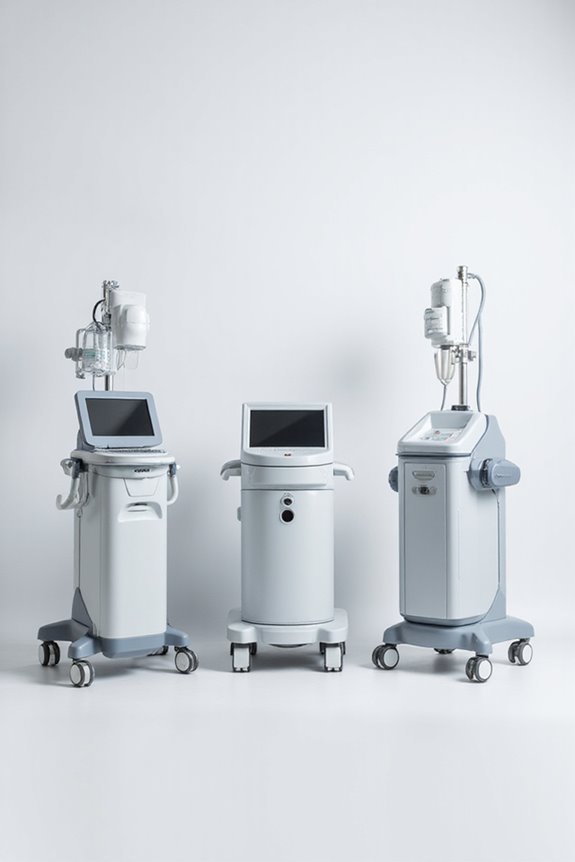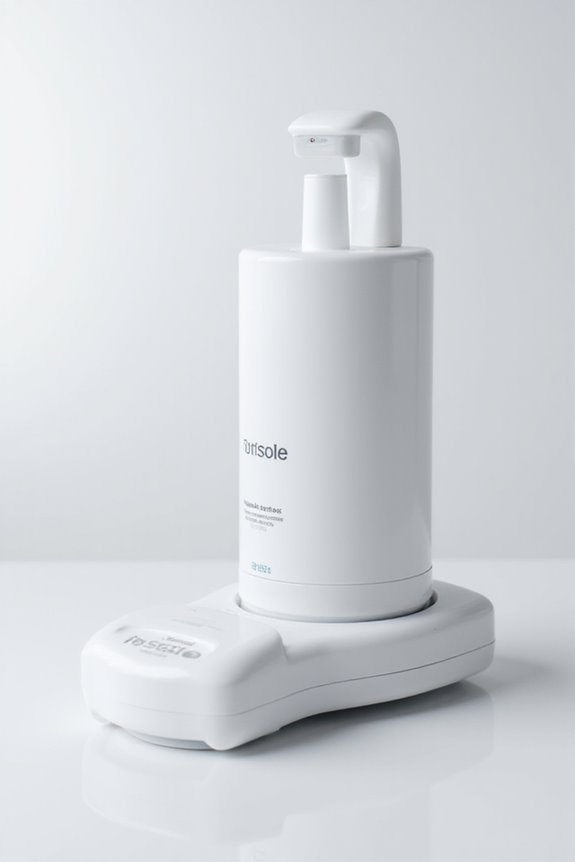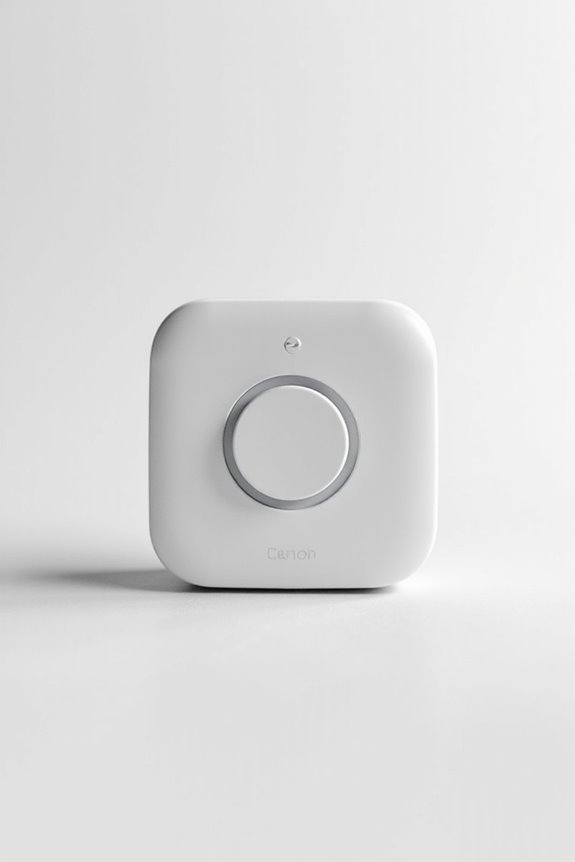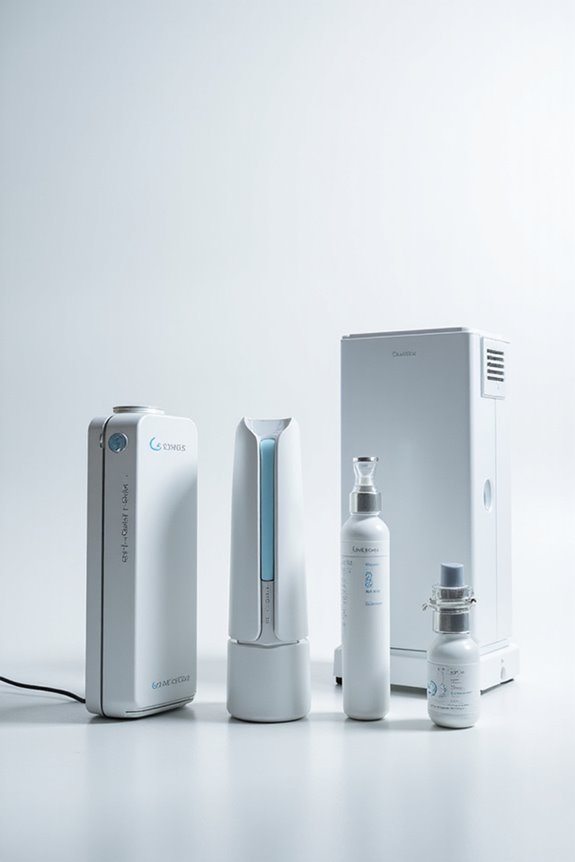Links below are affiliate links. We earn a commission on purchases at no extra cost to you. Although our opinions are based on curated research, we haven't used these products. Articles generated with AI. This article is for informational purposes only and does not constitute medical advice. Please consult a qualified professional for health-related questions.
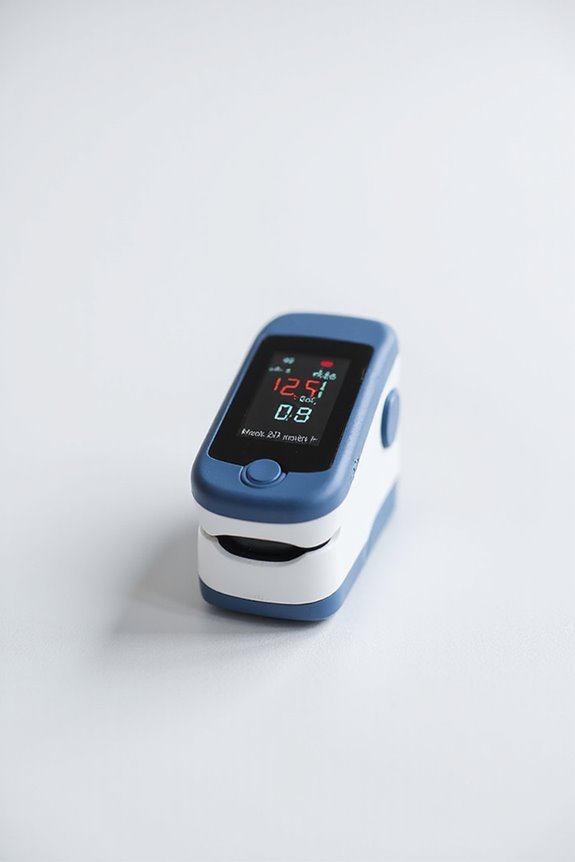
The 5 Best Oximeters With Alarm Features to Keep You Safe and Informed
If you’re looking for reliable pulse oximeters with alarm features, evaluate these top choices:
- EMAY Sleep Oxygen Monitor: Bluetooth-enabled with PC software for data tracking.
- Wellue O2Ring: Compact design with Bluetooth and excellent monitoring capabilities.
- Wellue O2 Pulse Oximeter: Smart reminders track oxygen levels with alarms.
- Fingertip Pulse Oximeter: Customizable alarms for both adults and children.
- Manhero Handheld Oximeter: Versatile for all ages with real-time monitoring.
Stay informed on what to evaluate when selecting an oximeter.
Key Takeaways
- The Wellue O2 Pulse Oximeter with Smart Reminder offers customizable vibration and audio alarms for low SpO2 and heart rate levels.
- Fingertip Pulse Oximeter features adjustable alarms for out-of-range readings, enhancing safety for both pediatric and adult users.
- EMAY Sleep Oxygen Monitor includes an alarm function that activates for low oxygen levels, ensuring timely health alerts.
- Manhero Handheld Pulse Oximeter provides continuous monitoring with adjustable alarms, suitable for both daily use and sleep tracking.
- The Wellue O2Ring Pulse Oximeter features timely alerts for health anomalies, ensuring you stay informed during sleep or daily activities.
EMAY Sleep Oxygen Monitor with Bluetooth and PC Software
Sale
EMAY Sleep Oxygen Monitor with PC Software & App | Bluetooth Pulse Oximeter Rechargeable for...
- Support Two Modes: 1. Spot Check-> Read your oxygen level in real time whenever needed without recording data 2. Continuous Tracking -> Record data second by second over...
- Stand-alone oxygen monitor with 72 hours built-in memory that you don’t need a smartphone to make it work. Wear it to sleep and take it off to sync in the morning....
- Audio alarm to wake you up once your oxygen or heart rate drops below threshold
The EMAY Sleep Oxygen Monitor with Bluetooth and PC Software is an excellent choice for individuals requiring reliable oxygen monitoring during sleep or exercise.
Key Features:
- Modes: Spot Check and Continuous Tracking.
- Memory & Setup: 72 hours built-in memory; no smartphone needed for basic use.
- Alarm Function: Activates if oxygen or heart rate dips below set levels.
- Design: Lightweight and rechargeable, no AAA batteries required.
Data Management:
- Software: Free PC software and mobile app for data analysis.
- Reporting: Generates professional reports for physician consultations.
User Comfort:
- Display: Easy-to-read with adjustable viewing angles.
- Sensor: Comfortable finger sensor, secure rubber strap provided.
Best For: Individuals seeking reliable and convenient oxygen monitoring during sleep or exercise.
Pros:
- User-Friendly: Easy setup and operation with a clear display and adjustable viewing angles.
- Accurate Data: Provides consistent readings comparable to professional hospital equipment, useful for medical consultations.
- Extended Battery Life: USB rechargeable with a long-lasting charge, allowing for multiple days of use without interruption.
Cons:
- Alarm Volume: Some users report that the alarm volume could be better, potentially impacting its effectiveness.
- Accessory Availability: The protective case, while a good option, comes at an additional cost that some may find unnecessary.
- Learning Curve: New users may need time to fully understand the software and data analysis features.
Wellue O2Ring Pulse Oximeter, Bluetooth Blood Oxygen Monitor
Wellue O2Ring Pulse Oximter, Bluetooth SPO2 Blood Oxygen Saturation Monitor - Wearable O2 Ring...
- COMFORTABLE SOFT RING SENSOR: The lightest, smallest ring sensor for continuous tracking, durable and adapt to most fingers.
- DETAILED APP & PC REPORT: Free APP & PC software provides graphic report and trends of data, reviewing real-time data in APP dashboard. Unlimited sharing of PDF and CSV...
- UNUSUAL DATA MARKING: If the SpO2 level is lower than the preset threshold and heart rate is lower or higher than the preset threshold, the device will mark it in the...
For active individuals seeking real-time monitoring of their blood oxygen levels, the Wellue O2Ring Pulse Oximeter offers a unique solution with its Bluetooth connectivity and wearable design.
Product Features
- Comfortable Design: Lightest, smallest ring sensor; fits finger sizes 2-3.2 inches.
- Data Management: Free app and PC software for reports, trends, and PDF/CSV sharing.
- Data Storage: Built-in memory stores 4 groups of 10-hour data; automatic Bluetooth upload.
- Rechargeable: Lasts up to 16 hours on a full charge; intended for sports and aviation use.
Users report comfort, but handling advice is necessary to prevent device damage. Awareness of stillness during measurements is essential due to potential discrepancies in data accuracy.
Best For: Active individuals and sports enthusiasts looking for a convenient and portable solution to monitor their blood oxygen levels in real-time.
Pros:
- Comfortable and lightweight design that fits a variety of finger sizes for extended wear.
- Comprehensive data management through a free app and PC software that provide detailed reports and trends.
- Rechargeable and long-lasting battery, allowing up to 16 hours of continuous use on a full charge.
Cons:
- Some users report issues with data accuracy, especially when moving during measurements.
- The device may feel bulky or fragile, necessitating careful handling to prevent damage.
- Occasional device resets during use can lead to frustrations with tracking consistency.
Wellue O2 Pulse Oximeter with Smart Reminder
Wellue O2 Pulse Oximeter with Smart Reminder | Blood Oxygen Saturation Monitor for SpO2 and Heart...
- 【Free APP&Software for Android, iOS&PC】The "Vihealth" App and "O2 Insight Pro" Software allow you to share all-day data and trend easily, or watch your real-time O2...
- 【Smart Vibration & Audio Reminder】The oximeter vibrates and keeps making a "drip" sound if blood O2 saturation falls below your defined level. Vibration and sound...
- 【All-day Monitoring】Checkme O2 Max records your O2 level (blood O2 saturation level), pulse rate, and motion with extremely accuracy.
Wellue O2 Pulse Oximeter with Smart Reminder stands out for individuals monitoring respiratory health, particularly those with chronic conditions requiring constant monitoring.
Key Features
- Continuous Monitoring: Tracks blood oxygen saturation (SpO2) and heart rate.
- Smart Alerts: Customizable vibration and audio reminders for low SpO2 and pulse rates.
- Connectivity: Bluetooth-enabled for data syncing with the Vihealth App (iOS, Android) and O2 Insight Pro software for PC.
- Battery Life: Lasts up to 72 hours on a single charge.
- Comfortable Design: Patented silicone ring sensor for a secure, soft fit.
This device helps guarantee timely interventions and effective health management.
Best For: Individuals monitoring respiratory health, especially those with chronic conditions requiring regular tracking of blood oxygen levels and heart rate.
Pros:
- Continuous monitoring of SpO2 and heart rate helps ensure timely health interventions.
- Customizable smart alerts provide timely notifications for low SpO2 and pulse rate.
- Long battery life of up to 72 hours on a single charge enhances usability and convenience.
Cons:
- Accuracy tolerance of ±2% may lead to variations in readings.
- Limited real-time graphing requires downloading data for trend analysis.
- Some users report issues with accidental factory resets and display usability.
Fingertip Pulse Oximeter for Pediatric and Adult Use
Fingertip pulse oximeter for pediatric Handheld oxygen saturation monitor rechargeable -Continuous...
- CONTINUOUS DETECTION & ACCURATE MEASUREMENT: Accurate handheld pulse oximeter, SpO2 measurement range between 70-100% accurate to 1%, heart rate (PR) measurement range of...
- MULTIPLE PROBE CHOICES:pediatric pulse oximeter with continuous monitoring foot sensor for infants , Compatible with both pediatric and adult use, the Adult Finger...
- Abnormal reminder & with alarm function:The baby oxygen and heart monitor can set the value range freely according to your blood oxygen data, automatic sound alert when...
Fingertip pulse oximeters equipped with alarm features are essential tools for monitoring oxygen saturation and heart rates in both pediatric and adult patients.
Product Features:
- SpO2 range: 70-100% (±1%)
- Heart rate: 25-250 bpm (±1 bpm)
- Pediatric and adult probes available
- Customizable alarm for out-of-range readings
- Historical data storage for tracking (up to 500 sets)
Design:
- Rechargeable via USB-C
- Full battery life: up to 8 hours
- Compact and lightweight for portability
Applications:
- Monitors infants (0-3 years) and adults
- Ideal for continuous monitoring in clinical settings
Best For: This product is best for families needing a reliable and easy-to-use pulse oximeter for continuous monitoring of oxygen levels and heart rates in both infants and adults.
Pros:
- Wide SpO2 and heart rate measurement range ensures accurate readings for various age groups.
- Customizable alarm features help alert users to out-of-range values, enhancing safety.
- Lightweight and rechargeable design promotes portability for use at home or on-the-go.
Cons:
- Not intended for medical purposes, limiting its use in clinical settings.
- Some challenges reported with infant probes, affecting consistent readings due to motion artifacts.
- Individual results may vary based on user experience and proper probe placement.
Manhero Handheld Pulse Oximeter for Infants and Adults
Pulse Oximeter Manhero handheld pulse oximeter Can continuously monitor infants and adults...
- Precise protection and continuous care: This precise handheld pulse oximeter is designed to meet the blood oxygen monitoring needs of infants and adults. Whether it is...
- Convenient to use: It has a flexible power supply method, supports AAA batteries for emergency use, and can be used anytime with data cable power supply, whether at home...
- Rich probe configuration: a continuous monitoring sensor designed specifically for infants, closely fitting the feet, effectively reducing measurement errors, ensuring...
The Manhero Handheld Pulse Oximeter excels in monitoring both infants and adults, making it an ideal choice for families seeking reliable health tracking.
Key Features:
- Continuous monitoring capability with adjustable alarms for pulse and SpO2 levels.
- Overnight monitoring option enhances usability during sleep.
- SpO2 range: 70-99% (accuracy: ±2%); Heart rate range: 30-240 bpm (accuracy: ±1 bpm).
Design and Usability:
- Flexible power options: AAA batteries or data cable.
- High-definition 2.4-inch screen with 9-level brightness for visibility.
- Specialized sensors for infants and ergonomic design for adults.
Monitoring and Alarm Functions:
- Audible alarms for SpO2 under 90% and heart rate below 50 bpm.
- Customizable thresholds for tailored health monitoring.
- Storage for 500 data sets facilitates historical trend analysis.
Best For: Families seeking an efficient and reliable device for monitoring the health of both infants and adults.
Pros:
- User-friendly design with specialized sensors ensures accurate readings for different age groups.
- Continuous monitoring with customizable alarms provides peace of mind for caregivers during sleep.
- Data storage capacity allows for easy tracking of health trends over time.
Cons:
- Loud alarm feature may disturb sleep when used at night, particularly in a quiet environment.
- Accuracy limitations at lower ranges may not meet the expectations for all users.
- Requires batteries or a data cable, which may limit portability or convenience in certain situations.
Factors to Consider When Choosing an Oximeter With Alarm
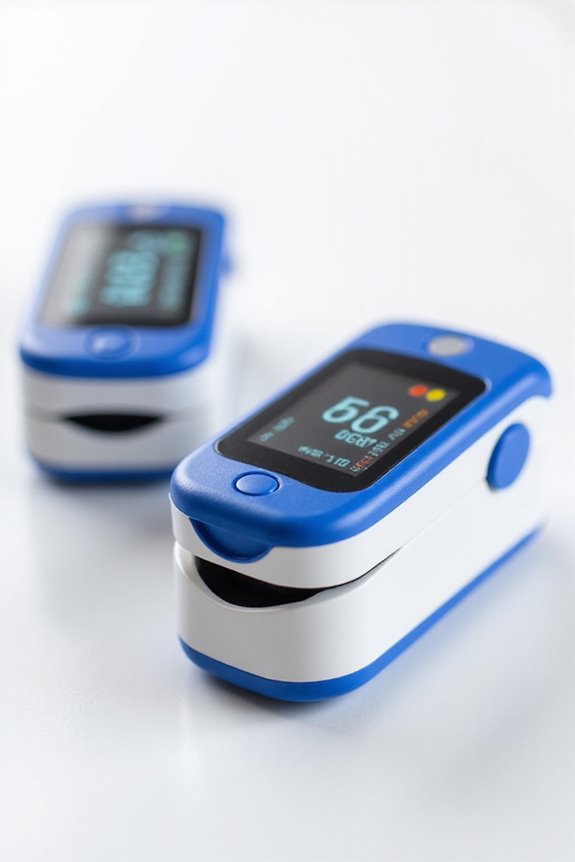
When choosing an oximeter with alarm functions, consider several key factors to guarantee it meets your needs. Monitoring capabilities, design comfort, data management features, alarm and notification systems, as well as battery life, all play vital roles in your decision-making process. Evaluating these aspects will help you select the most effective device for your health monitoring requirements.
Monitoring Capabilities and Features
Monitoring capabilities and features are crucial elements to evaluate in an oximeter equipped with alarm functions, as they directly influence its effectiveness in managing health conditions.
- Continuous Monitoring: Look for devices that track blood oxygen levels and heart rates in real time, guaranteeing you receive timely alerts for abnormalities.
- Adjustable Alarm Thresholds: Choose oximeters that allow customization of alarm settings for specific health needs, such as low SpO2 levels.
- Data Storage: Consider oximeters with built-in memory to store historical data, enabling you to review trends and share them with healthcare professionals.
- Display Features: Confirm the device provides clear and accessible screens, easy to read important statistics, including alarm status, even in low-light conditions.
These features contribute considerably to effective health monitoring.
Design Comfort and Portability
Design comfort and portability are key factors impacting user experience with oximeters equipped with alarm features.
- A comfortable design is vital, particularly for extended wear during daily activities or sleep.
- Look for lightweight, ergonomic models that enhance usability.
- Portability matters; compact, lightweight devices guarantee easy transport across settings like home, sports, and travel.
- Soft, non-slip materials in the sensor improve comfort during prolonged use.
- Opt for rechargeable options to eliminate disposable batteries, reducing weight and inconvenience.
- A user-friendly interface with a clear display can ease monitoring, particularly under varying lighting conditions.
Prioritizing these aspects helps you select an effective oximeter that meets your comfort and portability needs.
Data Management and Reporting
Effective data management and reporting are essential features to evaluate when selecting an oximeter with alarm capabilities. Consider the following factors:
- Built-in Memory: Look for devices that store historical data, enabling tracking of oxygen levels and heart rate over time.
- Data Export Options: Ascertain compatibility with common formats, like CSV or PDF, for easy sharing with healthcare professionals.
- Reporting Software/Apps: Choose oximeters with software or mobile apps that create graphic reports and trends for easier data interpretation.
- Customizable Settings: Opt for devices that allow you to set personalized alarm thresholds for low oxygen saturation or heart rates.
- Automatic Syncing: Select products that sync data in real-time with apps or software, enhancing health metric management.
Alarm and Notification Functions
When selecting an oximeter with alarm features, consider the essential role alarm and notification functions play in ensuring timely health monitoring.
- Alarm Types: Look for oximeters that offer audio and vibration alerts to notify you of critical changes in oxygen saturation (SpO2) or heart rate.
- Customizable Settings: Opt for devices with customizable alarm thresholds, allowing you to set specific SpO2 and heart rate limits that suit your individual health needs.
- Anomaly Reminders: Choose models that activate alarms for particular readings, ensuring immediate intervention when SpO2 drops below 90% or heart rates fall below 50 bpm.
- Continuous Monitoring: Consider oximeters with continuous monitoring capabilities for added assurance, especially during sleep or exercise.
Effective alarm functions enhance your responsiveness to essential health changes.
Battery Life and Rechargeability
Battery life and rechargeability are important factors to contemplate when selecting an oximeter with alarm features. Here are key considerations:
- Battery Life: Some oximeters operate for up to 72 hours on a single charge, while others last only 8 to 16 hours. Longer battery life enhances usability for continuous monitoring.
- Rechargeability: Devices with rechargeable batteries eliminate the need for disposables, reducing long-term costs and environmental impact.
- Charging Methods: Charging options like USB and proprietary cables can vary. Confirm compatibility with available power sources.
- Data Storage: Oximeters with built-in memory may allow data recording without draining battery life.
- Charging Time: Consider average charging times, as some devices may take several hours to recharge fully, impacting usage frequency.
Performance Accuracy and Reliability
Performance accuracy and reliability are paramount when selecting an oximeter with alarm features, as these factors directly impact your ability to conduct effective monitoring.
- SpO2 Accuracy: Look for devices with a tolerance of ±2%, guaranteeing trustworthy blood oxygen level readings.
- Consistency: Oximeters should produce results aligning with professional medical equipment for dependable use.
- Heart Rate Precision: Select units offering a heart rate accuracy of ±1 bpm to maintain reliable data.
- Movement Tolerance: Continuous monitoring devices should perform accurately during movement, preventing reading discrepancies.
- Battery Life: Long-lasting batteries and robust memory for historical data storage enhance reliability, facilitating uninterrupted use and easy tracking of health trends.
Prioritizing these elements guarantees superior functionality and satisfaction with your chosen oximeter.
Frequently Asked Questions
How Do Oximeters Determine Blood Oxygen Levels?
Oximeters determine blood oxygen levels through a non-invasive process. Here’s how they work:
- Light Absorption: They use light sensors that emit wavelengths of red and infrared light.
- Pulse Oximetry: The device calculates the ratio of oxygenated to deoxygenated hemoglobin by measuring how much light is absorbed.
- Display: The results are then displayed as a percentage, indicating your blood oxygen saturation levels.
This technology provides real-time monitoring of respiratory health.
Are Oximeters Safe for Long-Term Use?
Yes, oximeters are generally safe for long-term use. However, consider the following:
- Skin Concerns: Prolonged use can lead to skin irritation or pressure sores at the sensor site.
- Calibration: Regular calibration guarantees accuracy; inconsistent readings may necessitate reevaluation.
- Monitoring Frequency: Frequent use should be based on medical advice, particularly for individuals with chronic conditions.
Consult your healthcare provider for personalized recommendations regarding long-term monitoring practices with oximeters.
Can Oximeters Track Sleep Quality?
Yes, oximeters can track sleep quality, but their effectiveness varies. During sleep, they measure blood oxygen saturation levels which correlate with sleep apnea and other respiratory issues.
Key points:
- Continuous monitoring: Some advanced oximeters record data over hours.
- Data analysis: Look for devices that provide detailed reports on oxygen levels.
- Limitations: They don’t evaluate sleep stages or duration explicitly.
What Does an Alarm Indicate on an Oximeter?
An alarm on an oximeter indicates critical changes in your oxygen saturation levels. When saturation drops below a predetermined threshold, it triggers a signal, alerting you to potential health risks.
- Normal Levels: Generally, oxygen levels should stay above 95%.
- Alarm Triggers: If levels fall to 90% or lower, immediate attention is necessary.
This feature aids in prompt response to hypoxemia, enhancing your safety during monitoring.
How Often Should I Calibrate My Oximeter?
You should calibrate your oximeter at least once a year for accurate readings. Factors affecting calibration include:
- Age of the device: Older devices may drift in accuracy.
- Frequent use: Heavy usage can lead to wear.
- Environmental conditions: Extreme temperatures or humidity may impact performance.
Regular calibration guarantees reliability, helping you maintain precise measurements of your blood oxygen levels. Always refer to the manufacturer’s guidelines for specific calibration recommendations.






